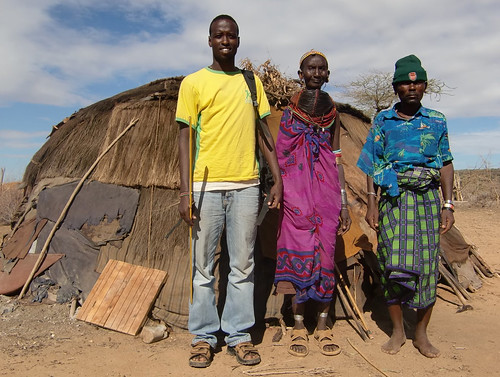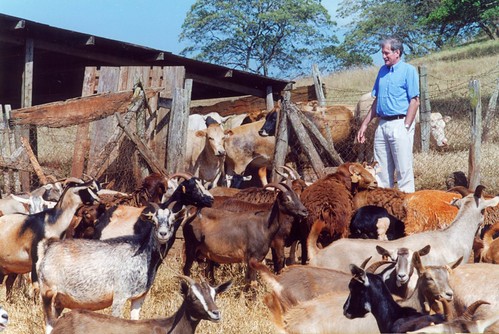ILRI researcher holds discussions with local pastoral herders in Marsabit, in Kenya’s northern drylands, for ILRI’s Index-based Livestock Insurance project (photo credit: ILRI/Mude).
SciDevNet reports that, due to the great drought engulfing the Horn of Africa, an ‘index-based’ livestock insurance scheme for herders in Kenya’s remote Marsabit District may make payments to those who had earlier purchased the insurance. This is the first time insurance has ever been offered Kenya’s remote livestock herders, and these would be the first payments for those who have insured their stock.
What is ‘index-based’ livestock insurance?
Index-based livestock insurance makes the risk-management benefits of insurance available to poor and remote clients. The product being piloted in Marsabit District by the International Livestock Research Institute (ILRI) and other partners, including the private sector, aims to provide compensation to insured pastoralists in the event of livestock losses due to severe forage scarcity. Incorporating remotely-sensed vegetation data in its design, delivered via mobile ICT-based transactions platforms, and with experimental extension methods used to educate the remote pastoral herders, this insurance product boasts many firsts in product development. Payments are triggered when severe drought makes forage scarce over a long period and when it can be predicted from that that more than 15 per cent of livestock in the area will have died of starvation.
SciDevNet reports the following.
‘Insurers will assess in October whether Kenyan farmers signed up to the Index-Based Livestock Insurance scheme will receive their first payment, after the worst drought in the region for 60 years.
‘The scheme, which has been piloted in northern Kenya since early 2010, uses freely-available satellite data to assess the state of pastures. When the images show that pastures have dried up, farmers can claim compensation for animals that have died as a result—without insurers having to verify the deaths in person.
‘In Kenya about 2,500 farmers have purchased the product since its inception, paying a yearly premium of up to US$100 for 6–8 animals. . . .
‘”So far, the predicted mortality [rate is] high—but we have to wait for the final tally at the end of October in order to determine whether or not there will be a payout,” said Brenda Wandera, project development manager at the International Livestock Research Institute (ILRI), Kenya, which implemented the scheme.
‘The scheme will be extended to southern Ethiopia in February 2012 to help mitigate the effects of drought. It will initially target 2,700 pastoralists.
The aim is to find a viable insurance tool that could cushion pastoralists from heavy losses experienced during droughts, according to Wandera.’
‘ILRI will partner with the Nyala Insurance s.c. company in Ethiopia, with support from the International Food Policy Research Institute, the US international development agency USAID and the World Bank. . . .’
The technical partners in this project
Cornell University
Index Insurance Innovation Initiative
Syracuse University (Maxwell School)
University of Wisconsin (BASIS Research Program)
The implementing partners
Equity Insurance Agency
UAP Insurance Limited
Financial Sector Deepening (FSD) Kenya
Kenya Meteorological Department
Kenya Ministry of Development of Northen Kenya and other Arid Lands
Kenya Ministry of Livestock
The donor agencies
UK Department for International Development (DFID)
United States Agency for International Development (USAID)
World Bank
Read the whole article at SciDevNet: Kenyan farmers may soon receive first drought payout, 15 Aug 2011.
For more information, visit the blog of ILRI’s Index-Based Livestock Insurance project.



